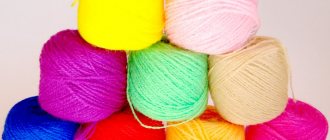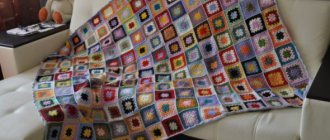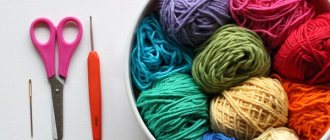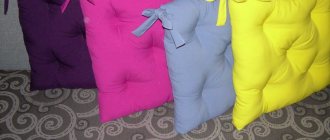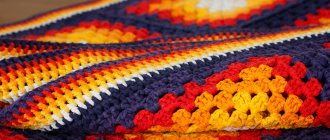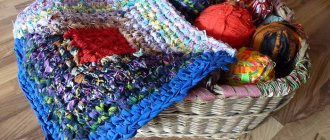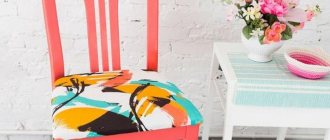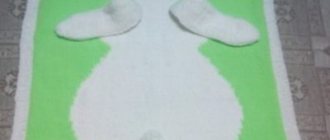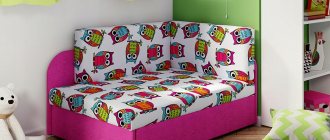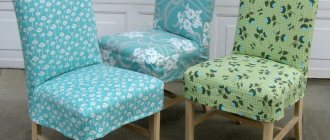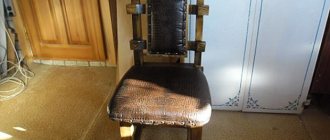A person who loves to knit always surrounds himself with wonderful things. The bed will not be left without attention - we will create a lovely bedspread or blanket for it. There are special covers for sofas and armchairs. You can even knit adorable covers. But this article will tell you about the stool and chair. And how to make them cozier with a crochet hook.
- Square cover for stool
- Crochet chair back cover
Selecting a product model
Hand-knitted chair covers do not go unnoticed in the interior. To prevent them from looking tasteless, you must take into account the overall style of decoration and furnishings. Vintage covers made from leftover yarn or products made using the granny square technique will fit well into country and Provence interiors. If the room is decorated in a modern direction, cape models made from thick yarn are suitable. They can have neutral white, beige, gray, powdery shades, or they can act as bright accents in red, yellow, and blue. This option would be appropriate in Scandi, eclectic, eco-style, and loft styles.
A cover on a stool or chair usually serves several functions, primarily decorative. A fashionable, hand-made detail enlivens the space and lifts your spirits. With the help of a new cover, you can refresh old furniture and hide defects that have formed on its surface over time. Hard, cold seats become more comfortable when knitted chair covers appear on them. Covers made in the same style make the kitchen furniture unified. This is especially true if the stools or chairs are different.
The most commonly used cape models are:
- solid (made of a single fabric covering the back and seat);
- separate (consisting of two separate parts);
- capes for the back (a festive design option, usually in harmony with the tablecloth);
- seat covers (looks like a flat pillow covering a horizontal surface).
Crocheted stool covers belong to the latter category. They follow the shape of the seat and are divided into round and square. Often made with sides.
Capes are attached to furniture in various ways. It is convenient to use for this:
- ties or Velcro;
- elastic band;
- cord threaded along the edge;
- the tapering edge of a cape.
All models are knitted according to specific furniture sizes, so before you start working, you need to take measurements from a chair or stool. Crochet instructions with patterns can be adjusted by adding or subtracting rows to the desired size.
Decoding the scheme
The process of creating covers for stools and chairs may seem difficult for beginning craftswomen. First of all, you need to use detailed crochet tutorials with patterns. The latter consist of symbols that should be carefully studied:
- Oval - air loops (VP).
- Crosses - single crochets (SC).
- T - half double crochet.
- T crossed out - single crochet.
- T crossed out twice - with two double crochets.
- T crossed out three times - with three double crochets.
- X with a loop on top - a twisted column.
- X with a line on top is a connecting loop.
Drawings and procedures for assembling a step stool with your own hands
Crocheting for beginners requires following some rules. Schemes are always viewed only from bottom to top; circular options are read in the direction from the central part to the edges. Odd rows are determined from right to left, even rows, on the contrary, from left to right. The creation of round capes begins from the middle; thanks to the lifting loops, the optimal parameters of the product are maintained.
A square or round cape for beginners usually consists of 3 types of loops: chain stitches, double crochets and single crochets, and connecting stitches. Despite this, the products turn out to be attractive and interesting.
Materials and tools used
Unlike clothing, furniture covers require stiffness, so thick twisted yarn is the best option. These products are notable for the fact that you can use almost any type of thread for them. If they are thin, they are simply folded several times. In addition, this yarn can be used to knit delicate openwork capes for the backs of chairs.
You should be aware of the shrinkage of some types of material. First of all, this applies to natural fibers - cotton, wool. When working with them, you need to first wet and dry the yarn, or add a few centimeters to the measurements for shrinkage.
Synthetic covers, on the contrary, tend to stretch over time. For them, stock is not needed; it is better to provide the ability to tighten or reduce the product if necessary. You can knit capes from fashionable knitted yarn, which produces beautiful textured products that do not require decoration.
A knitted or synthetic cover can be sewn to a fabric base so that it does not deform.
Stool covers made of round polyester cord are practical and do not lose their shape. Some knitters use yarn made from plastic bags for such projects. They protect the surface well, but are not very comfortable to the touch.
Products made from bulky merino wool look impressive, but are not practical enough. Sitting on them may cause pellets to appear; such a fabric can easily get caught. Various scraps of yarn are often used to crochet chair and stool covers. With a skillful combination of colors, such things turn out bright and beautiful.
All types of yarn should have the same thickness. If thick and thin threads are used for work, then the latter should be used in 2 or more folds.
The hook for the covers must match the diameter of the thread. Usually an instrument of at least 3 numbers is used. When choosing a hook material, it is better to choose steel. Due to the high density of knitting, plastic and wooden tools may break, and aluminum tools may bend.
Cotton
Wool
Knitwear
Polyester cord
Merino wool
Hooks
What threads are used to knit chair covers?
You can use various threads for clothing on furniture. But it is not advisable to have a high wool content. A very warm thread will be inappropriate in the summer. The thickness should be above average. There are no and cannot be any restrictions on color. The Creator is a designer and a magician.
Particular attention to thorny threads .
They can be used. As pharmacologists say, this place will tolerate anything (this is about drugs and injections). An exception may be high chairs.
Knitting algorithm depending on the model
Making capes is a simple and interesting process. Using detailed diagrams and descriptions, you can update your interior while mastering crochet for beginners. Conventional abbreviations:
- VP – air loop;
- Dc – double crochet;
- RLS – single crochet;
- PS – lush column;
- ST - regular column.
Square in patchwork style
This chair cover is made up of 25 small square motifs that are knitted together. Quantity may vary depending on seat size. For the cover you need to take yarn of two colors. The motifs are arranged in a checkerboard pattern, so half of them are knitted with a light center and a dark binding, and the others - vice versa. Stages of work:
- Knitting begins with a ring of 6 VP.
- 4 bundles of 3 SSN are knitted into it, between which are arches of 3 VP.
- 3 dc, 3 ch, 3 dc are knitted into the corner arched holes. Between these groups there is an arch of 3 VPs.
By knitting one square motif, you can accurately calculate their number for a stool. After the chessboard is ready, you need to tie it:
- the first row of the binding is a DC of the same color;
- the second is a DC of a different color;
- third row - alternating CCH and 1 VP.
Ties are attached to the edges of the cover to secure it to the stool. You can also use Velcro. The choice depends on the knitter's preferences.
Round with sides
A cover for a round stool made with a “popcorn” pattern is soft due to the many “bumps” on the surface. For it you will need threads of three colors: white, black, green (or any others). The number of rows is determined as work progresses and depends on the diameter of the stool, the knitting density and the thickness of the yarn. Alternating colors can be done as follows: 2 rows - white, then 1 - black, 2 - green, 2 - white, 1 - black.
Knitting stages:
- To get started, you need to make a ring of 5 VPs.
- Next, 2 VP lifts are made and another 7 RLS are knitted into the ring.
- Then 1 SP is knitted over each sc. It is formed by 5 CCHs, created on one loop of the base and united by a common loop on top. An arch of 2 VPs is made between the groups.
- In the next row, 2 VPs are knitted into each arch from 2 VPs - 5 VPs are cast on, a yarn over is made, a hook is inserted into the VP of the base and a long loop is pulled out. Between all groups of columns, 2 VPs are knitted.
- All other rows are performed similarly until the circle reaches the diameter of the seat. After this, you can begin to form the side. To do this, a RLS is knitted into each PS, and 2 RLS are knitted into each arch.
- Next, rows of columns are knitted until the side reaches a height of 10 cm. An elastic band is pulled into its edge, which helps to tighten the cover after it is put on the seat. You can make the sides with the same “popcorn” pattern, which will make the round stool look more voluminous and unusual.
Square made of thick yarn
The easiest way to make square or rectangular covers for a stool is to crochet a fabric of the desired size, working from one edge to the other. In this case, the product unfolds after the end of each row. A square cape made of thick yarn does not require a complex pattern, because such threads themselves look expressive and embossed. You can use simple patterns using the uniform knitting technique. Master Class:
- First you need to dial a chain of VP, which will be equal to the length of the finished product.
- Then make 3 VP lifts and knit a DC in the first loop from the hook.
- After this, create 1 VP and knit together with 2 Dcs - from the same loop and from the second one from the hook.
- Again 1 VP and again 2СН together. Knit the entire row in this manner. The result is a pattern resembling a small zigzag.
This canvas will look more interesting if each new row is made in a different color. You can choose contrasting shades, or you can make smooth transitions from light to dark and back.
In the form of a flower
An elegant case resembling a daisy can be knitted from dense threads in two colors. The light version is used for the base, and the dark version is used to trim the edges and border the petals. Work algorithm:
- Knitting begins from the center of the flower. A chain of 5 VP is closed into a ring and tied with 6 PS from 2 ST. Between them arches are made from 2 VP.
- 12 PS, 2 in each arch. Between them there are 2 VPs.
- It is knitted similarly to the previous one, but 1 VP is made between each stitch.
- Next, 3 VP lifting, then 1 VP, 1 Dc in the second arch from the hook, 2 VP, Dc in the same place.
- In each arch of 2 VPs, 2 CCHs, 2 VPs, 2 CCHs are knitted. Between these groups there is 1 VP.
- In arches of 2 VPs, 3 CCHs, 3 VPs, 3 CCHs are performed. Between groups - 1 VP.
- In this row, the fans look like this: 4 dc, 3 ch, 4 dc. Between them there is 1 VP.
- 1 more dc is added to the fans on each side.
- A fan of 2 CC2H, 6 CC, 2 CC2H is knitted into arches of 3 VP. Between fans - 1 VP.
The flower is framed with a contrasting thread. This way the product will look unusual and attractive. Progress:
- The fans are tied like this: 4 ST, then 4 double stitches (2 ST are knitted into each loop of the previous row), 4 ST.
- Having reached the air loop separating the petals from each other, the knitting is turned and 2 arches of 2 VP are made, and then 4 arches of 1 VP are made towards the center of the flower. Thus, a chain of VPs is obtained along the left edge of the petal.
- Then the knitting is turned again and a symmetrical chain is made along the right edge of the adjacent petal towards the edge. The process is repeated until all parts of the flower are tied.
A knitted daisy will fit well into the interior of a children's room. It will bring joy to the child and parents. In addition, such a cover will protect the chairs from external damage.
Back cover
The cape on the back of the chair can be made using the same technique as the seat cover, or it can be the only decoration of this piece of furniture. In this case, options for several products make up a composition with a tablecloth or napkin on the dining furniture. Covers made using the openwork knitting technique from light yarn will be an elegant addition to the festive table.
Stages of work:
- A chain of VP is assembled, the length of which is equal to the width of the part, the number of loops is a multiple of 8. Each row will begin with 3 VP and end with 1 Dc in the last loop of the previous row.
- After lifting into the fifth loop from the hook, we knit a fan: 3 dc, 1 ch, 3 dc. Then dc is made in the fifth loop from the hook. This sequence must be continued until the end of the row, all subsequent ones must be performed similarly.
- After both parts are ready, they need to be sewn on three sides and put on the back of the chair.
How to knit a round seat
Round stools have taken a strong place in the kitchen. And with intensive use, their surface quickly becomes unusable. By covering the seat with a rug, you will extend the life of the stool. Knitting a round cape is the easiest thing to do. But despite this, the result exceeds expectations.
This product will decorate any room. To begin, dial a chain of 4 v. p. and knit a circle of the required diameter according to the pattern.
If you wish, you can knit a border around the edge that will hold the cape on the seat.
Decoration methods
Ready-made covers for a stool or chair can easily be made even more attractive. To do this, you can use one of the ways to decorate them:
- add lace or fringe around the perimeter;
- attach lush tassels at the corners;
- tie the edge with fancy yarn (for example, a pompom or “grass”);
- decorate a plain product with bright embroidery;
- use the appliqué technique;
- sew large flat buttons onto the cover;
- turn children's capes into animal faces;
- complete the composition by dressing the chair legs in knitted “socks” or “gaiters.”
When decorating capes, you shouldn’t try to use all the ideas at once. The finish should be in harmony with the color of the cover and its texture. There is no need to decorate an openwork product with pompoms, or sew an applique onto a colored cape.
Some decorating tips:
- bright details will look good against a plain background;
- fringe and pompoms are suitable for products made from thick yarn;
- small covers for chair legs are best made from the same yarn as the main cape;
- if the item is knitted from several types of yarn, the finishing should repeat one of them.
Using simple recommendations, you can create a stylish and cozy item suitable for any interior. Even a beginner knitter can knit a cover. It should be remembered that capes should fit favorably into the interior of the room.
How to decorate: types of decor
Knitting is a process that is impossible without the work of imagination and imagination. Since crocheting patterns for a stool cover mostly involve simple shapes, why not decorate them:
- Lace and tassels. This element looks good around the edges. Especially on a square shape.
- Embroidery. Both classic beads or rhinestones and top processing with threads are used.
- Bows. They look good made from ribbons or fabric, and also knitted.
- Pompoms. Like tassels, they will perfectly decorate a cape, except that this is more suitable for children’s furniture.
To create it, you need to knit a sufficient number of individual colors and then connect them, guided by the diagram.
You can also use various patterns or unusual combinations of all kinds of circles, squares, lines and zigzags as decorations. For more experienced ones, it makes sense to “play around” with the form.
Photo
Shutdown
The resulting flat fabric should continue to be knitted evenly, without any additions, trying it on the stool from time to time. If knitting covers for a stool involves placing a soft foam lining underneath them, then fitting should be carried out together with this part.
When the width of the fabric reaches a size that allows you to put the cover on the stool, it’s time to finish knitting. You can tighten the finished product on a stool using an elastic band or any lace threaded between the loops of the last row. This case successfully combines functionality with decorativeness.
Square seat
The square one can be knitted according to the same pattern as the rectangular one, or you can make a more original colored version. In this case, the knitting goes from the middle in a circle.
Make rows with single crochets under the front wall. On each row, add stitches at the corners to create a square shape. In the second row, in the corners, place the hook under the air loops.
Using the same pattern, you can even knit a hexagonal rug, the main thing is to evenly add loops at the corners.
The diagram below will help you navigate. If you don't follow it, some difficulties may arise. For example, uneven expansion of the mat, bumps or depressions. Wrong proportions.
Adviсe
Before you start knitting chair rugs, you need to turn to useful tips and recommendations from already experienced needlewomen.
First of all, of course, you need to take care of the yarn. And there are many options here! A beautiful rug can be made even from old things or rags. The result will look no worse.
If you prefer to work with purchased yarn, then it is better to choose synthetic yarn. The most popular are acrylic or cotton with synthetic fibers. Please note that the threads must be very thick. Then the finished rug will be dense and warm. When knitting openwork patterns, it is better to choose, on the contrary, thin yarn.
Before knitting the rug itself, knit a small square with the same pattern and yarn that will be used in the planned product. Then wash and iron it. This will help you find out the number of stitches needed to knit a rug. Just count the stitches in ten centimeters and multiply by the desired size!
The scheme itself can be anything. You don’t have to look specifically for diagrams for stools; you can take the description of a floor mat or a cushion cover and simply fill in your measurements.
There is no need to buy new yarn if you have leftovers of different colors lying around at home. It's easy to make a beautiful product out of them. However, remember that the thickness of the yarn should be the same, so collect the threads carefully.
If it seems to you that the finished rug will quickly lose its shape, then you can make the base from thick fabric. Just sew them to each other. Be sure to eventually tie the rug with additional rows to make the product look finished and beautiful.
Crochet chair seat in the shape of a lotus
Loading…
Using the proposed patterns, you can also make a decorative pillow or rug. You can also connect two items in this style, which will complement each other and look harmonious in the room.
- When finished, the chair seat will have a diameter of about 38 cm.
- This article presents products in two colors, so you will need to choose the yarn for work in the color you plan to make the product.
- For knitting we need the following:
- Hook 3-4 mm thick;
- acrylic or cotton yarn in the following colors: white, three shades of yellow and red. Or white, three shades of blue and dark blue.
We will knit the product in stages: first we knit the base, then we make the flower petals.
